Tropical garden design brings a splash of paradise to your backyard with lush greenery, vibrant flowers, and exotic plants. It’s all about creating a lively and inviting space that transports you to warmer climates. By blending color, texture, and natural elements, you can elevate any outdoor area into a beautiful retreat that’s perfect for relaxation or entertaining friends and family.
Integrating Water Features for Serenity
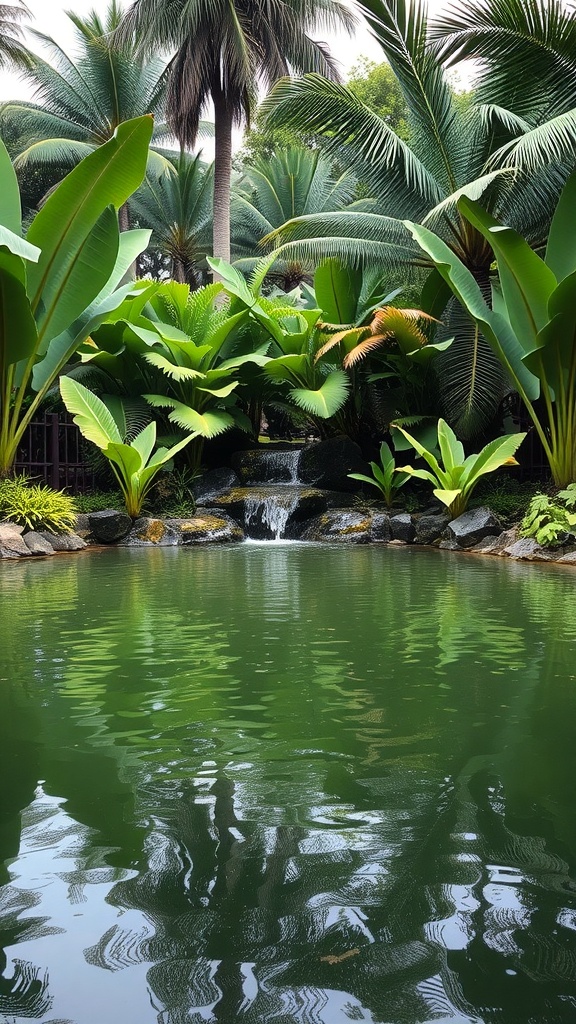
Water features can truly transform a tropical garden into a peaceful retreat. The image showcases a serene pond surrounded by lush greenery, creating a natural oasis. The gentle sound of a waterfall adds to the calming atmosphere, inviting you to relax and unwind.
Incorporating a pond like this one can enhance the beauty of your garden. The reflections on the water’s surface mirror the vibrant foliage, making the space feel larger and more connected to nature. Adding aquatic plants can further enrich the environment, providing habitat for local wildlife.
Consider placing seating nearby to enjoy the view and sounds of the water. This setup encourages moments of tranquility, whether you’re meditating, reading, or simply enjoying the scenery. A water feature not only beautifies the space but also promotes a sense of peace and relaxation.
Designing Pathways with Natural Materials
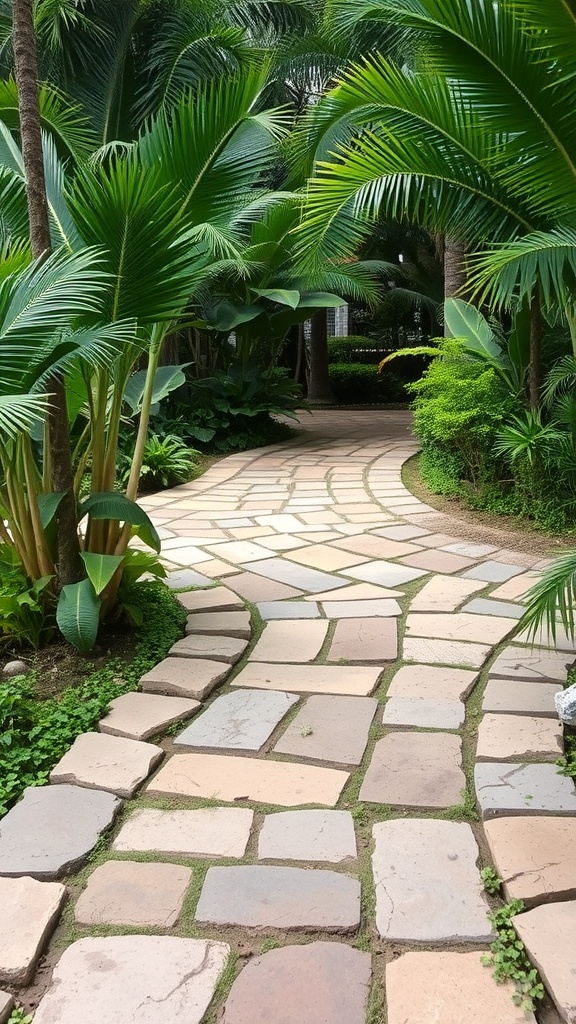
Creating pathways in a tropical garden can really enhance the overall feel of the space. The image shows a beautiful winding path made of natural stone, surrounded by lush greenery. This kind of pathway invites you to explore the garden while blending seamlessly with the environment.
Using natural materials like stone not only looks great but also provides durability. The varied colors and textures of the stones add character to the path. Notice how the stones are laid out in a way that creates a gentle curve, making the walk feel more organic and less rigid.
Surrounding the path with tropical plants, like the tall palms and vibrant foliage seen here, adds to the tropical vibe. These plants not only provide shade but also create a sense of privacy and tranquility. When designing your own pathways, think about how the plants will interact with the path.
Another great aspect of this design is the way the path is integrated into the landscape. It doesn’t just lead somewhere; it becomes part of the journey. You can imagine wandering along this path, discovering different plants and enjoying the sounds of nature. This connection with the surroundings is key in tropical garden design.
Choosing the Right Hardscape Elements
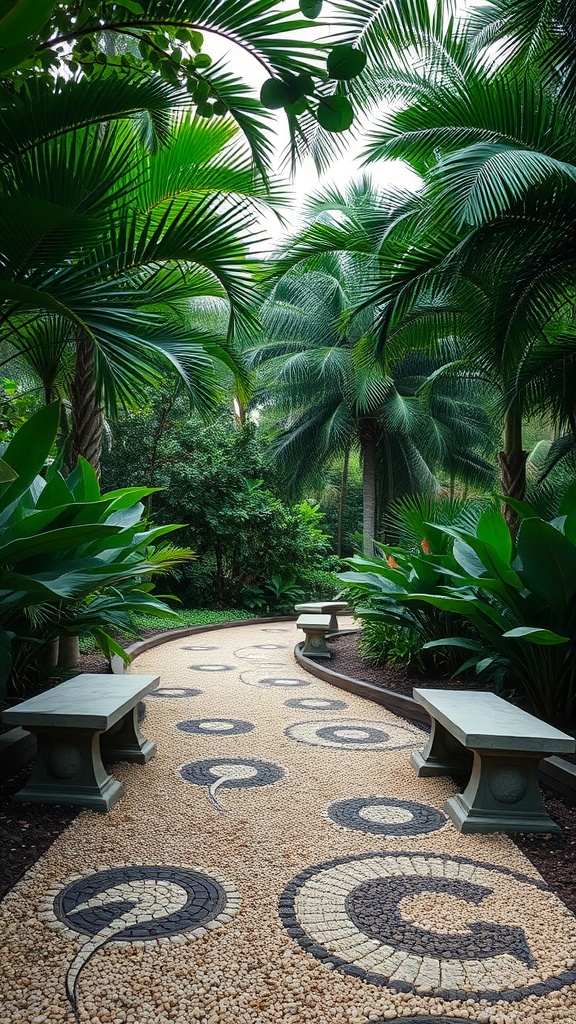
Creating a tropical garden is not just about the plants; hardscape elements play a big role too. The image shows a beautifully designed path winding through lush greenery. This path is made of different materials, giving it a unique look.
When selecting hardscape elements, think about how they complement the plants around them. The benches in the image provide a perfect spot to relax and enjoy the scenery. Choosing materials that blend with the natural surroundings can enhance the overall feel of your garden.
Consider using stones or tiles that mimic natural textures. The circular patterns in the path add visual interest and guide the eye through the garden. This can create a sense of flow, making the space feel more inviting.
Lighting is another important aspect. Well-placed lights can highlight the path and create a magical atmosphere at night. Incorporating these elements thoughtfully can transform your tropical garden into a serene retreat.
Utilizing Vertical Space with Climbing Plants
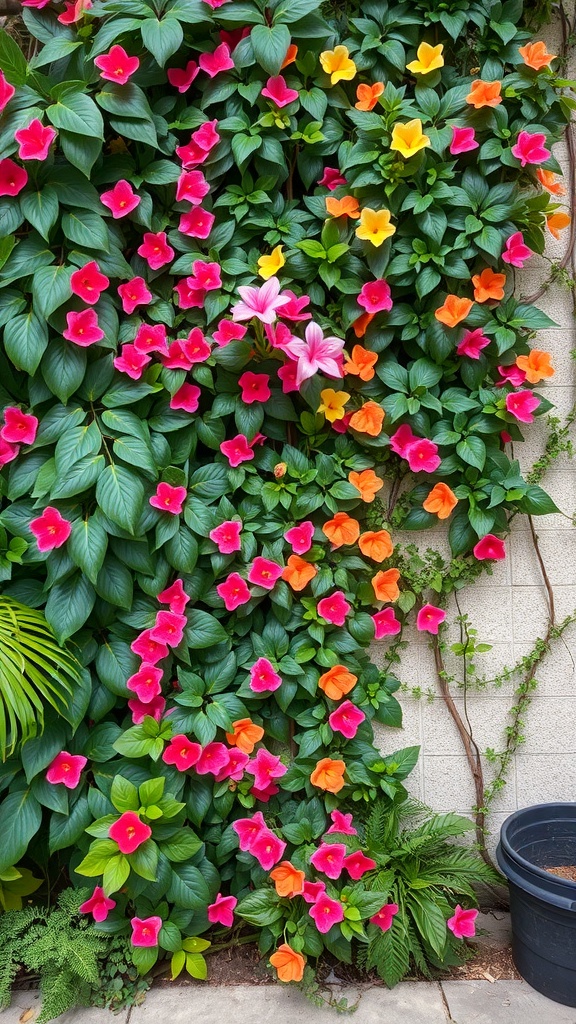
Vertical gardening is a fantastic way to make the most of your outdoor space. Climbing plants can transform bare walls into vibrant displays of color and life. The image shows a stunning wall covered in climbing flowers, showcasing a mix of bright pink, orange, and yellow blooms.
These climbing plants not only add beauty but also help create a lush atmosphere. They can soften hard surfaces, making any garden feel more inviting. The variety of colors in the image highlights how different blooms can complement each other, creating a cheerful and lively setting.
Using climbing plants is also practical. They can provide shade and privacy, making your garden a cozy retreat. With the right support, these plants can thrive and flourish, turning vertical spaces into eye-catching features.
Consider incorporating climbing plants into your garden design. They can be trained to grow on trellises, fences, or even walls, maximizing your space while adding a splash of color. This approach not only beautifies your garden but also encourages biodiversity, inviting pollinators and other wildlife.
Creating Shade with Canopy Trees
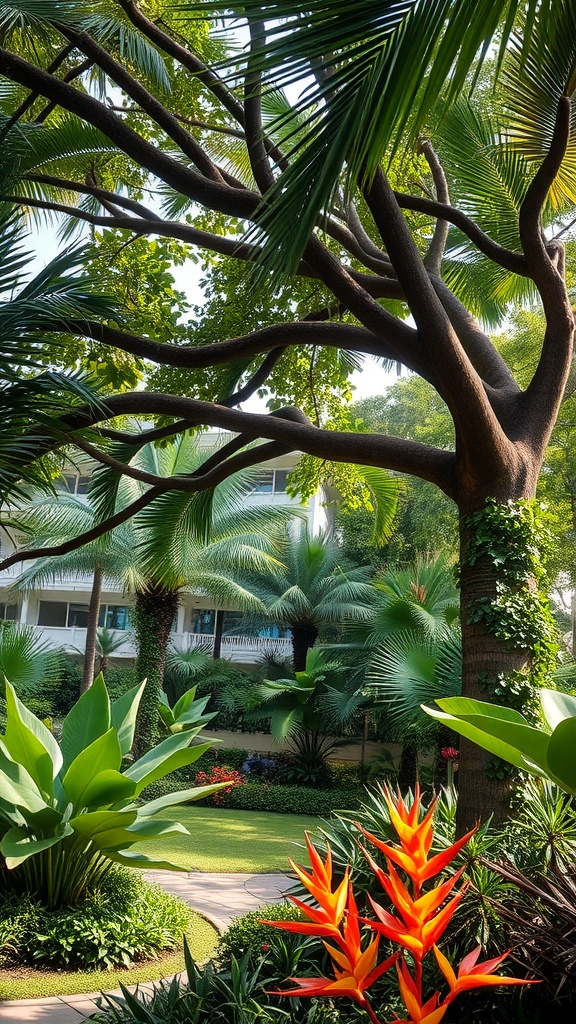
Canopy trees play a vital role in tropical garden design. They provide essential shade, making outdoor spaces more comfortable. In the image, you can see a majestic tree with sprawling branches, creating a natural umbrella over the garden below.
These trees not only offer relief from the sun but also enhance the beauty of the landscape. The vibrant green leaves contrast beautifully with the colorful flowers in the foreground. This mix of colors adds life and interest to the garden.
When selecting trees for your garden, consider their size and growth habits. Larger trees can create a significant amount of shade, while smaller varieties can add layers and depth. The right choice will depend on your garden’s layout and the amount of sunlight you want to filter through.
Incorporating canopy trees can also support local wildlife. Birds and insects often find shelter in their branches, contributing to a thriving ecosystem. So, planting these trees is not just about aesthetics; it’s about creating a balanced environment.
Incorporating Exotic Flowers for Visual Impact
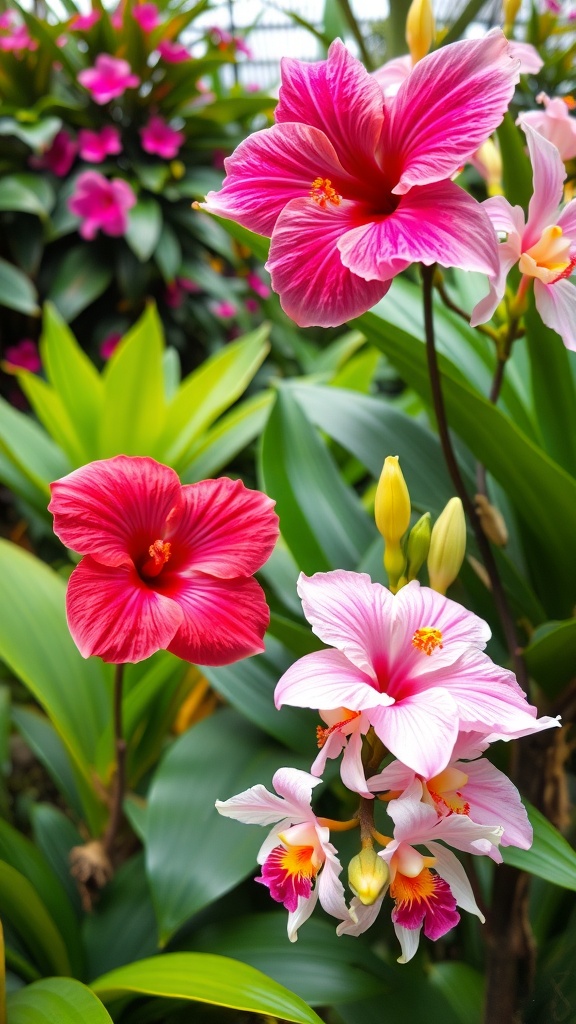
Exotic flowers can truly transform a garden into a vibrant paradise. The image showcases a stunning array of tropical blooms, featuring bold colors and unique shapes that catch the eye. These flowers, like the pink hibiscus and delicate orchids, add a sense of drama and beauty to any outdoor space.
When designing a tropical garden, think about layering different types of flowers. This creates depth and interest. The contrast between the bright pinks and the lush green leaves enhances the overall visual appeal. Mixing textures is also key; combining smooth petals with more textured foliage can make your garden feel alive.
Don’t shy away from using clusters of these flowers. Grouping them together can create a focal point that draws attention. Consider the height of each plant as well. Taller flowers can serve as a backdrop, while shorter ones can fill in the front, creating a balanced look.
Incorporating exotic flowers not only beautifies your space but also invites pollinators like butterflies and bees. This adds another layer of life to your garden, making it a lively and dynamic environment. With the right selection, your garden can become a stunning retreat that feels like a tropical getaway.
Creating a Lush Focal Point with Palms
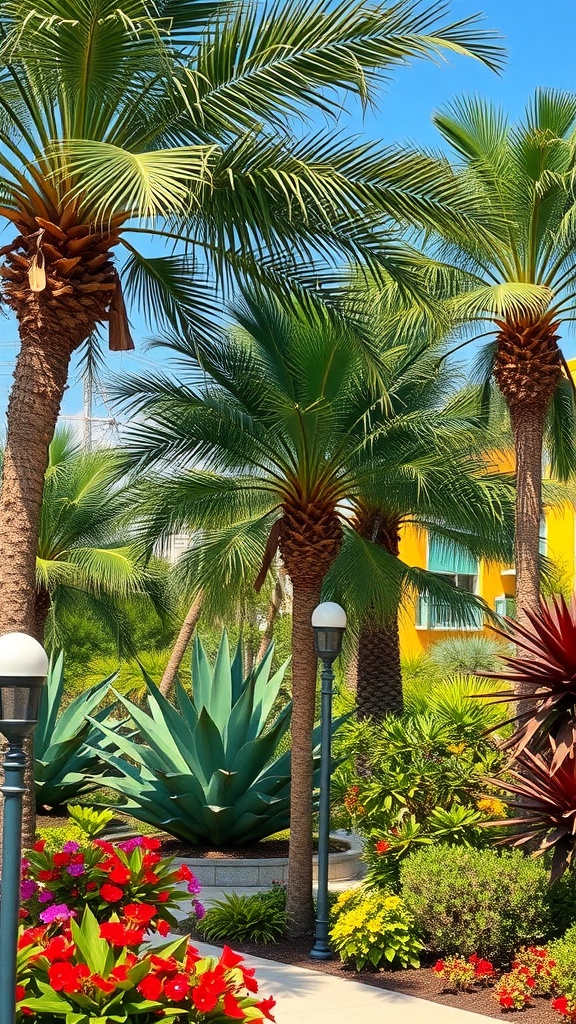
When designing a tropical garden, palms can be the star of the show. Their tall, graceful trunks and fan-like fronds create a striking visual that draws the eye. In the image, you can see a variety of palms standing proudly, surrounded by vibrant flowers and lush greenery. This combination adds depth and interest to the garden.
Palms thrive in warm climates and can be used in various ways. They can serve as a backdrop or a centerpiece, depending on your layout. The tall palms in the image provide height, while the colorful flowers at their base add a pop of color. This balance makes the garden feel inviting and lively.
Incorporating different types of palms can enhance the overall design. Consider mixing species with varying heights and leaf shapes. This creates a dynamic look that keeps the garden engaging. Pairing palms with other tropical plants, like agave and colorful blooms, can also help create a lush environment that feels like a getaway.
Lighting can further enhance the beauty of your palm focal point. Soft garden lights can highlight the textures of the palms and flowers at night, making the space usable after sunset. Overall, using palms effectively can transform your garden into a tropical paradise.
Incorporating Tropical Fruits for Edibility
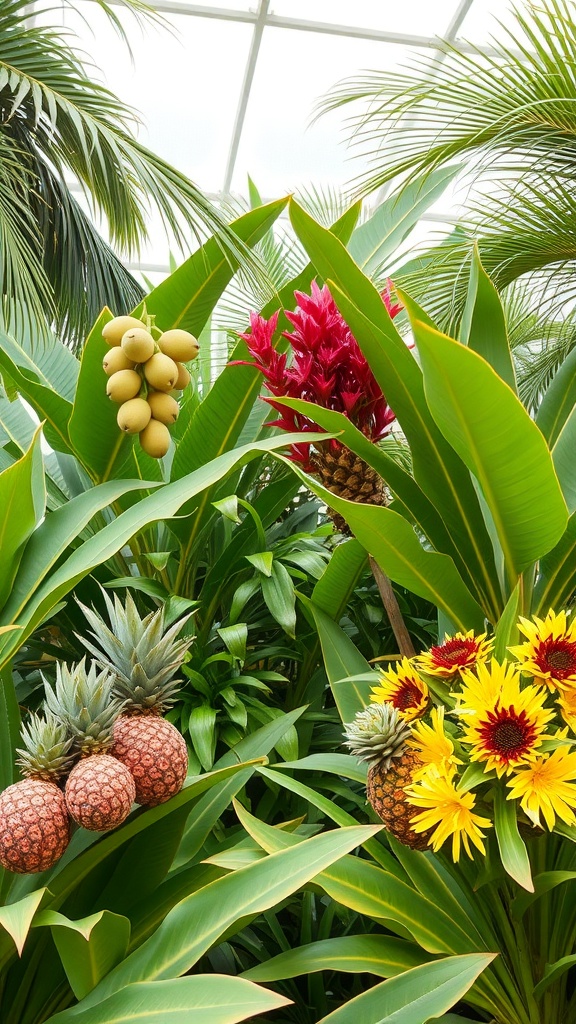
Imagine walking through a lush tropical garden filled with vibrant colors and exotic scents. The image showcases a variety of tropical plants, including pineapples, colorful flowers, and unique fruits. This is the essence of a tropical garden design that not only pleases the eye but also offers delicious edibles.
Incorporating tropical fruits into your garden can be both fun and rewarding. Fruits like pineapples and bananas are not just beautiful; they can also be a tasty addition to your meals. You can enjoy fresh fruit right from your garden, which adds a special touch to your culinary creations.
When planning your garden, think about the layout. Grouping fruits together can create a stunning visual effect. For example, placing bright yellow flowers next to green leaves and ripe pineapples can make your garden pop. This combination not only attracts attention but also invites pollinators, helping your plants thrive.
Don’t forget about the care these plants need. Tropical fruits often require warm temperatures and plenty of sunlight. Make sure to choose a spot in your garden that gets enough light. Regular watering and proper soil will also help your plants flourish.
Lastly, consider the flavors you want to bring to your kitchen. Tropical fruits can be used in smoothies, salads, or even desserts. The possibilities are endless, and having fresh fruit at your fingertips makes cooking more enjoyable.
Selecting Low-Maintenance Plants for Ease
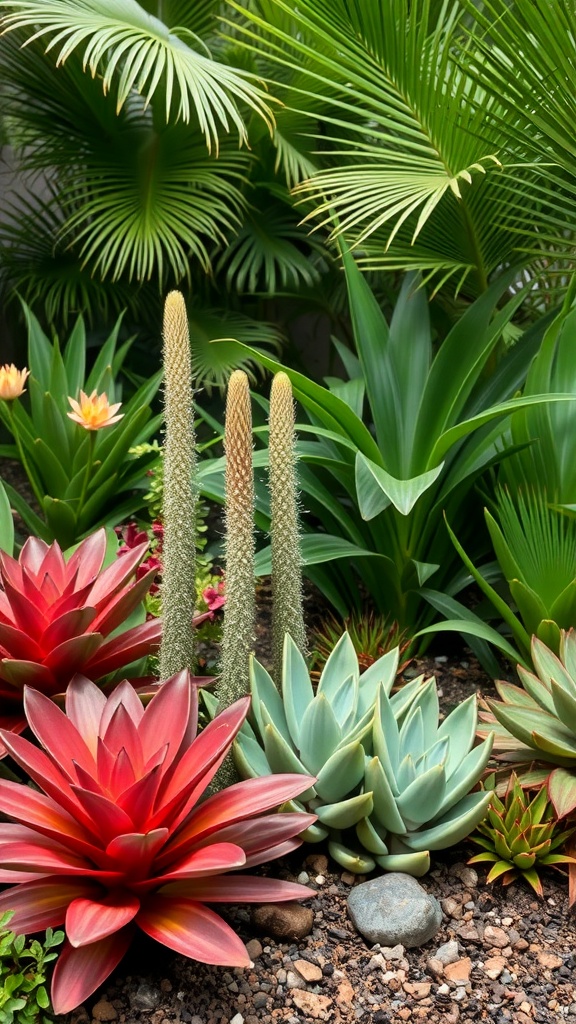
Creating a tropical garden can be a fun and rewarding project. One of the best parts is choosing low-maintenance plants that thrive in warm climates. The image shows a vibrant mix of tropical plants, showcasing a variety of colors and textures.
The striking red bromeliads in the foreground add a pop of color, while the tall, spiky cactus offers a unique contrast. Surrounding foliage, like the lush green leaves, creates a beautiful backdrop. This combination not only looks great but also requires minimal upkeep.
When selecting plants, consider options like succulents and cacti. They need less water and can handle the heat well. Tropical plants like palms are also excellent choices. They provide shade and can grow in various conditions. By picking these types of plants, you can enjoy a stunning garden without spending too much time on maintenance.
Incorporating Lighting for Nighttime Ambiance
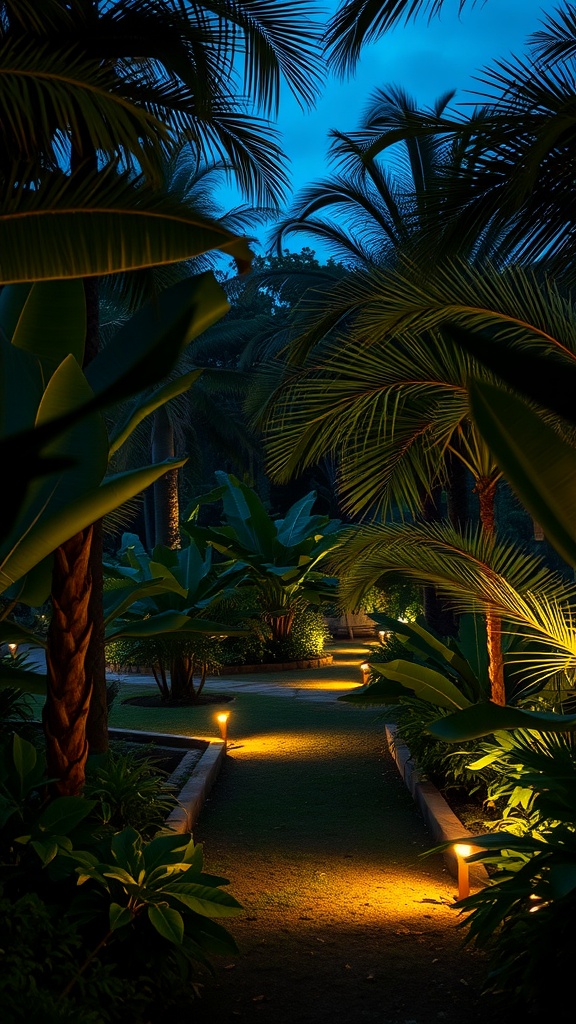
Lighting plays a key role in creating a tropical garden that shines even after the sun sets. The image shows a beautifully illuminated pathway lined with lush greenery, inviting you to take a stroll. Soft lights highlight the contours of the plants, making the space feel warm and welcoming.
Using subtle lighting along pathways not only enhances safety but also adds a magical touch. The glow from the lights creates a contrast against the darkening sky, making the garden feel alive at night. Consider using solar-powered lights or low-voltage options to keep things eco-friendly.
Strategically placing lights near palm trees and large leaves can create interesting shadows and textures. This adds depth to your garden, making it a perfect spot for evening gatherings or quiet moments. Don’t forget to experiment with different light colors to find what suits your style best!
Using Textures to Add Depth and Interest
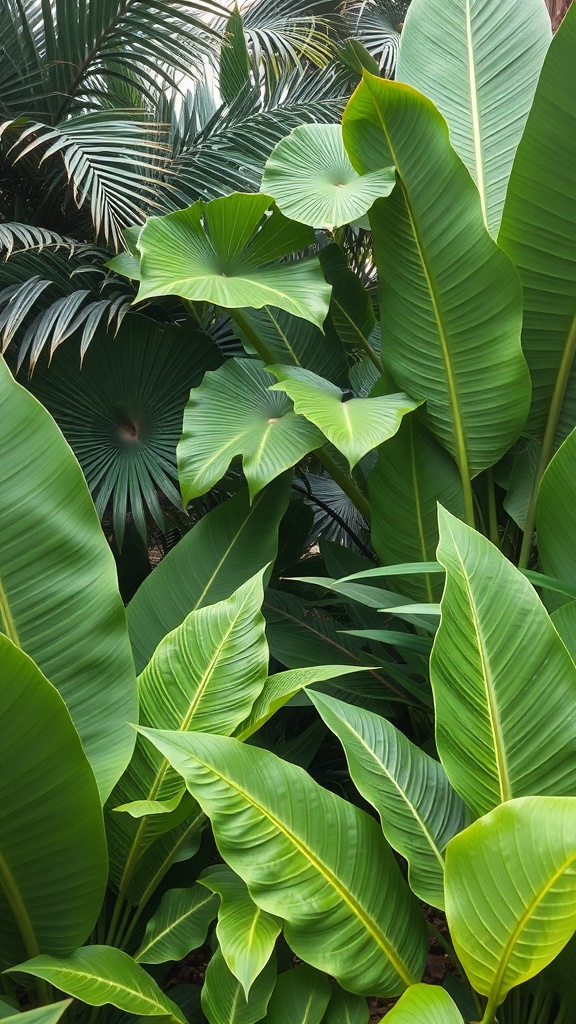
In a tropical garden, textures play a key role in creating a lively atmosphere. The image shows a variety of lush green leaves, each with unique shapes and sizes. This variety adds visual interest and depth to the garden.
Large, broad leaves, like those from banana plants, contrast beautifully with the more delicate, fan-shaped leaves of palm trees. This mix creates a dynamic look that draws the eye. Layering different textures can make the garden feel more inviting and vibrant.
When designing your tropical garden, think about how different plants can complement each other. For example, pairing smooth, glossy leaves with rougher textures can create a balanced feel. This not only enhances the beauty of the space but also encourages exploration.
Incorporating various textures can also highlight specific areas of your garden. You might want to use taller plants in the back and shorter ones in front, creating a tiered effect. This arrangement allows each plant’s unique texture to shine.
Planning for Seasonal Changes in Planting
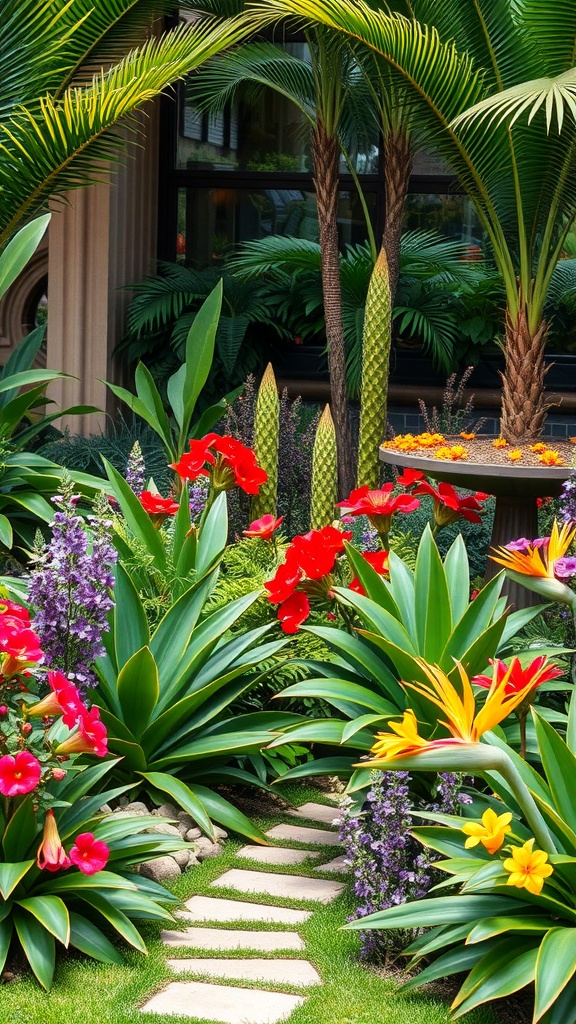
Creating a tropical garden is a fun way to bring a splash of color and life to your outdoor space. The image shows a vibrant garden filled with lush greenery and bright flowers. You can see a pathway made of stones winding through the plants, inviting you to explore.
When planning for seasonal changes, think about which plants thrive in different times of the year. Some flowers bloom beautifully in spring, while others shine in summer. Mixing these varieties ensures your garden looks lively all year round.
Consider the height and spread of plants too. Taller plants can provide a backdrop for shorter ones, creating depth and interest. The tropical look often features large leaves and bold colors, so don’t shy away from using striking plants like bird of paradise or hibiscus.
Don’t forget about maintenance. Some tropical plants may require more care during certain seasons. Regularly check for pests and ensure your plants get enough water, especially during dry spells. This will help keep your garden looking fresh and healthy.
Designing Outdoor Living Spaces for Enjoyment
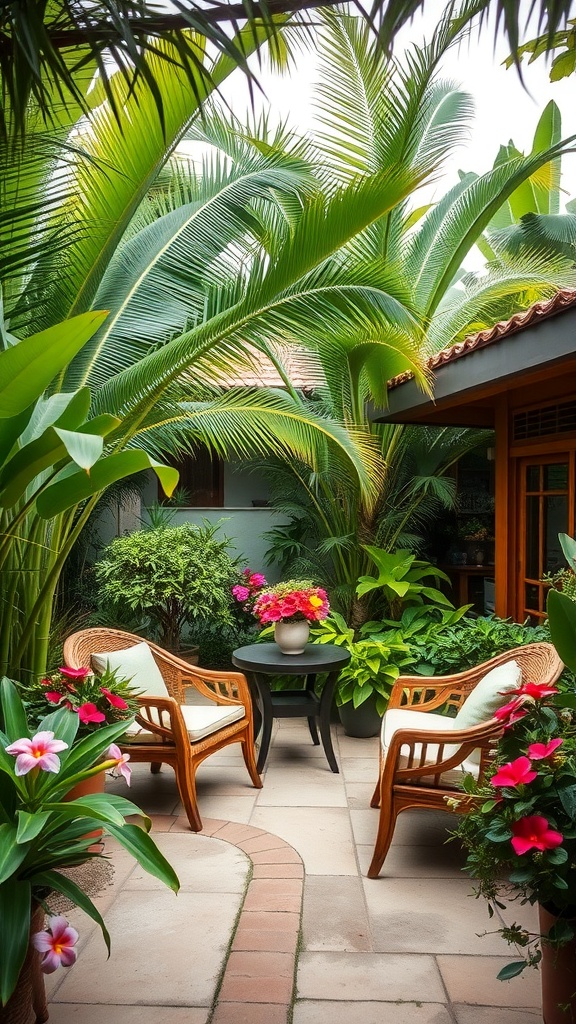
Creating an outdoor living space can bring joy and relaxation right to your home. The image shows a cozy corner in a tropical garden, perfect for unwinding. The lush greenery and vibrant flowers create a welcoming atmosphere.
The seating arrangement is simple yet inviting. Two comfortable chairs sit around a small table, making it an ideal spot for morning coffee or evening chats. The surrounding plants add a touch of nature, enhancing the overall experience.
Pathways made of stone lead through the garden, encouraging exploration. This design invites you to take a stroll and enjoy the beauty of your surroundings. Incorporating elements like these can turn any outdoor area into a delightful retreat.
Whether you want to entertain guests or simply enjoy some quiet time, a well-designed outdoor space can meet your needs. Consider adding personal touches, like decorative pots or unique plant arrangements, to make the area truly yours.
Creating Microclimates for Diverse Plant Growth
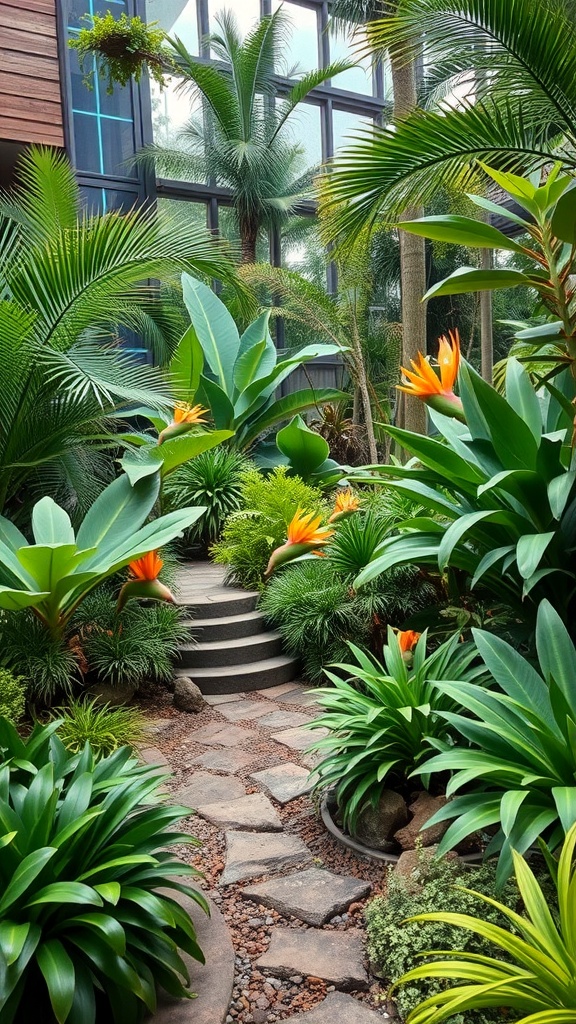
In a tropical garden, creating microclimates is key to thriving plant life. The image showcases a vibrant pathway surrounded by lush greenery and colorful blooms. This setup not only looks inviting but also plays a significant role in plant health.
Microclimates are small areas where the climate differs from the surrounding environment. In the garden, tall plants and structures can provide shade, while stones and pathways can absorb heat. This balance helps various plants flourish, each needing different conditions.
For instance, the bird of paradise flowers add a pop of color, thriving in sunny spots. Meanwhile, the surrounding ferns and palms enjoy the cooler, shaded areas. By strategically placing plants, you can create a diverse ecosystem.
Using natural elements like rocks and pathways can enhance drainage and soil warmth. This encourages root growth and overall plant vitality. So, when designing your tropical garden, think about how to use these features to create those essential microclimates.
Using Color Theory to Enhance Garden Aesthetics
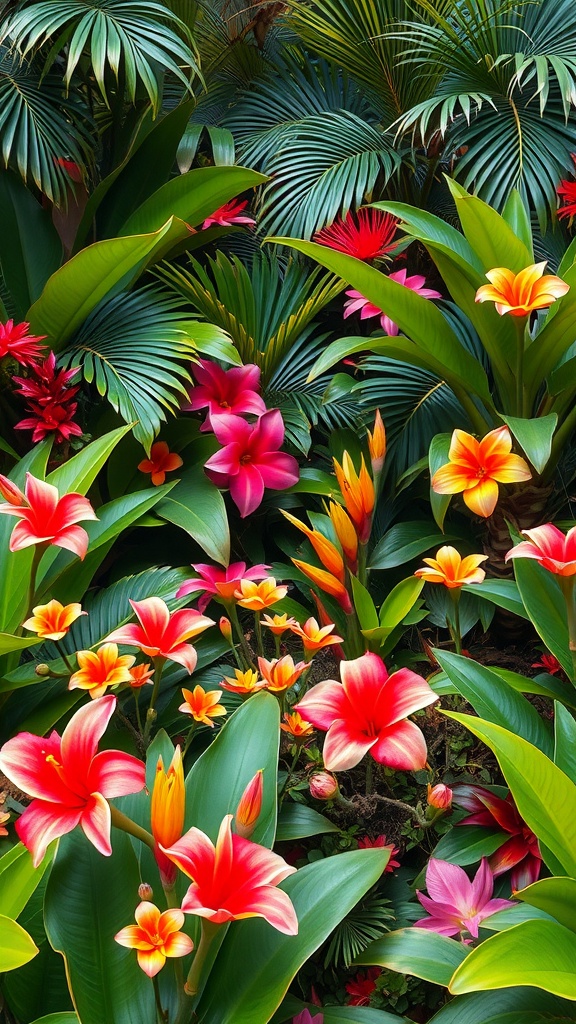
Color plays a vital role in creating a tropical garden that feels alive and inviting. The vibrant mix of pinks, reds, and yellows in this garden showcases how colors can work together to create a stunning visual experience. Each flower stands out against the lush green leaves, drawing the eye and creating a sense of harmony.
When designing your garden, think about the emotions different colors evoke. For example, warm colors like red and yellow can bring energy and warmth, while cooler colors like blue and purple can create a calming effect. This tropical garden uses warm colors effectively, making it feel lively and cheerful.
Layering colors can also enhance depth. Notice how the bright flowers peek through the greenery, creating a layered effect that adds interest. This technique can make even a small space feel more expansive and inviting.
Don’t forget about the importance of balance. Too many bright colors can be overwhelming, while too few can feel dull. Aim for a mix that feels natural and pleasing to the eye. This garden strikes a perfect balance, making it a delightful place to spend time.
Incorporating Sustainable Practices in Garden Design
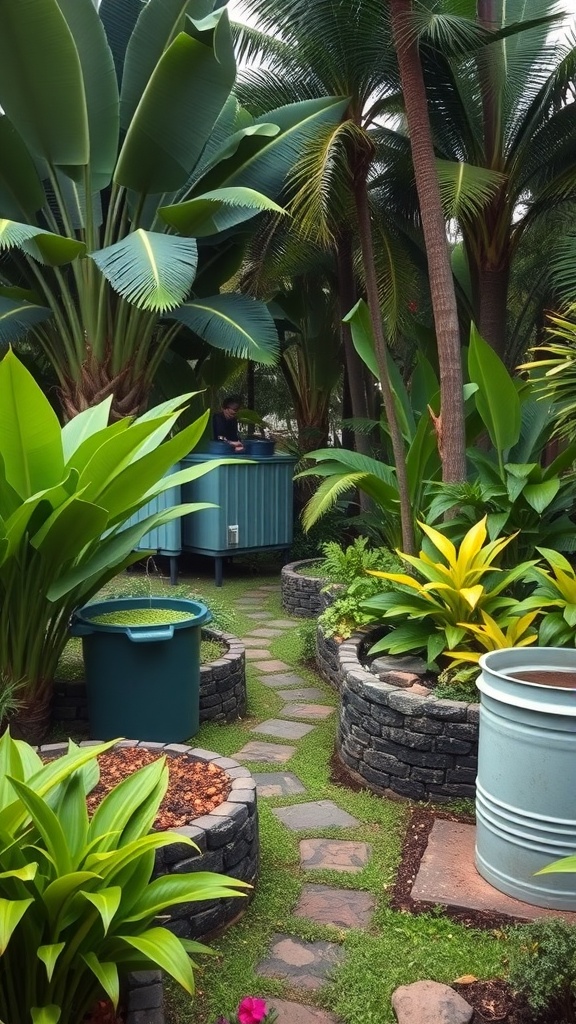
Creating a tropical garden can be a delightful experience, especially when you focus on sustainability. The image shows a lush garden filled with vibrant plants and a well-designed pathway. This setup not only looks beautiful but also promotes eco-friendly practices.
Using native plants is a great way to start. They require less water and care, making them perfect for a sustainable garden. The large leaves in the image suggest that these plants are well-suited for the tropical climate, thriving with minimal maintenance.
Rainwater harvesting is another sustainable practice. The blue containers in the image hint at a system for collecting rainwater. This helps reduce water waste and provides a natural source for irrigation. It’s a simple yet effective way to keep your garden healthy.
Incorporating stone pathways, like the ones shown, can also enhance sustainability. They allow for better drainage and reduce soil erosion. Plus, they add a charming touch to the garden, guiding visitors through the greenery.
Lastly, consider composting. The circular stone beds in the image could easily be used to create a compost area. This not only recycles kitchen waste but also enriches the soil, promoting healthy plant growth.
Combining Indoor and Outdoor Spaces Seamlessly
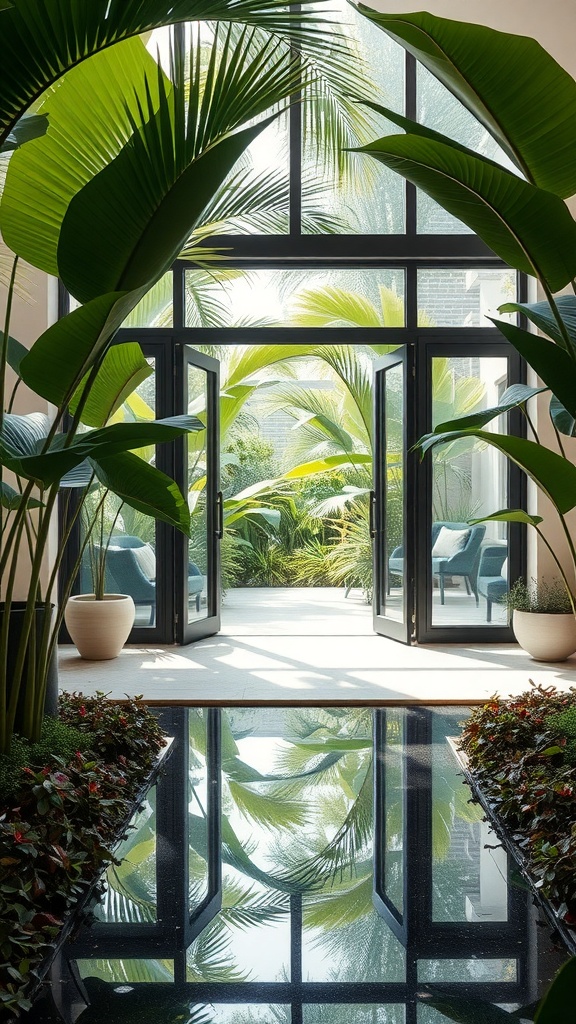
Creating a tropical garden design means blending indoor and outdoor spaces in a way that feels natural and inviting. The image shows a beautiful transition from a lush indoor area to an outdoor garden. Large glass doors open up to a vibrant green space, allowing sunlight to flood in.
The tall palm leaves and colorful plants create a lively atmosphere. This setup encourages a sense of connection with nature. The reflection in the sleek surface adds a touch of elegance, enhancing the overall aesthetic.
When designing your space, think about how to incorporate similar elements. Use large windows or glass doors to bring the outdoors in. Choose plants that thrive in both environments. This approach not only beautifies your home but also promotes a calming vibe.
Consider adding comfortable seating areas both inside and outside. This invites relaxation and makes it easy to enjoy your garden from different angles. With the right design, your indoor and outdoor spaces can feel like one harmonious retreat.
Creating a Wildlife-Friendly Environment
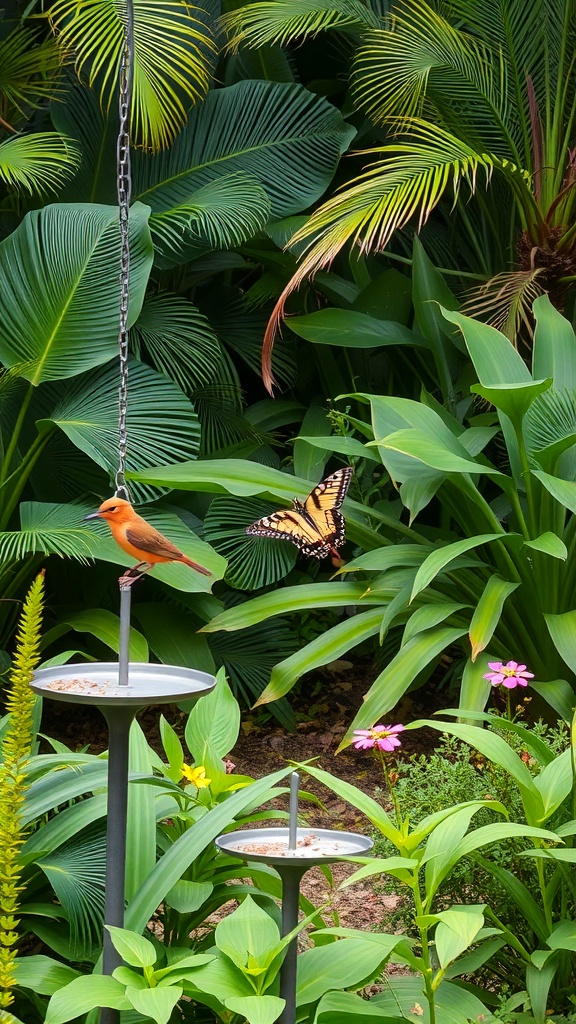
Creating a tropical garden is not just about beautiful plants; it’s also about inviting wildlife into your space. The image shows a vibrant scene with a bird perched on a feeder and a butterfly fluttering nearby. This lively interaction highlights how a garden can become a haven for various creatures.
To attract birds and butterflies, consider adding feeders filled with seeds and nectar plants. The bright colors of flowers can draw in pollinators, while the feeders provide a reliable food source for birds. Choosing native plants is a great way to support local wildlife.
Incorporating water features, like small ponds or birdbaths, can also enhance your garden. These elements not only provide hydration but also create a serene atmosphere. The sound of water can be soothing and attract more wildlife.
Creating a wildlife-friendly environment means thinking about shelter too. Dense foliage and shrubs offer safe spaces for birds and insects. This way, your garden becomes a thriving ecosystem, full of life and activity.
Utilizing Containers for Versatility in Planting
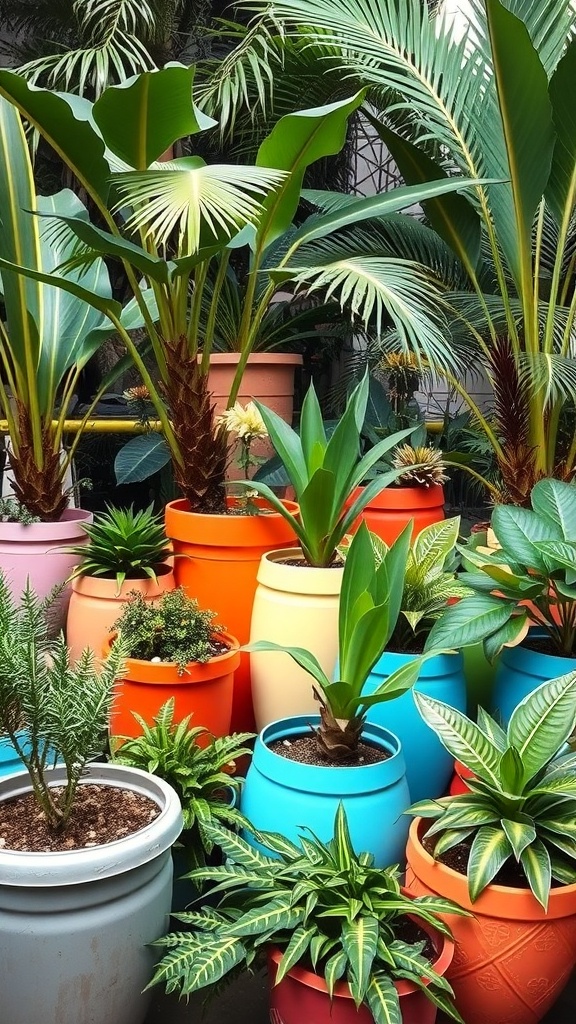
Containers are a fantastic way to bring life to your tropical garden. They allow you to mix and match plants, creating a vibrant display that can change with the seasons. The image shows a colorful array of pots filled with lush greenery, showcasing how containers can enhance your garden’s look.
Using different sizes and shapes of pots adds depth and interest. The bright colors of the containers in the image draw the eye and create a cheerful atmosphere. You can easily rearrange them to refresh your garden’s layout or to accommodate seasonal changes.
Container gardening is also practical. It allows you to control soil quality and drainage, which is essential for tropical plants that thrive in specific conditions. Plus, you can move pots around to find the perfect spot for sunlight or shade.
Don’t shy away from mixing various plant types. The image illustrates how different species can coexist beautifully in one space. Experiment with foliage textures and colors to create a lush, tropical feel. This approach not only looks great but also makes caring for your plants easier.
